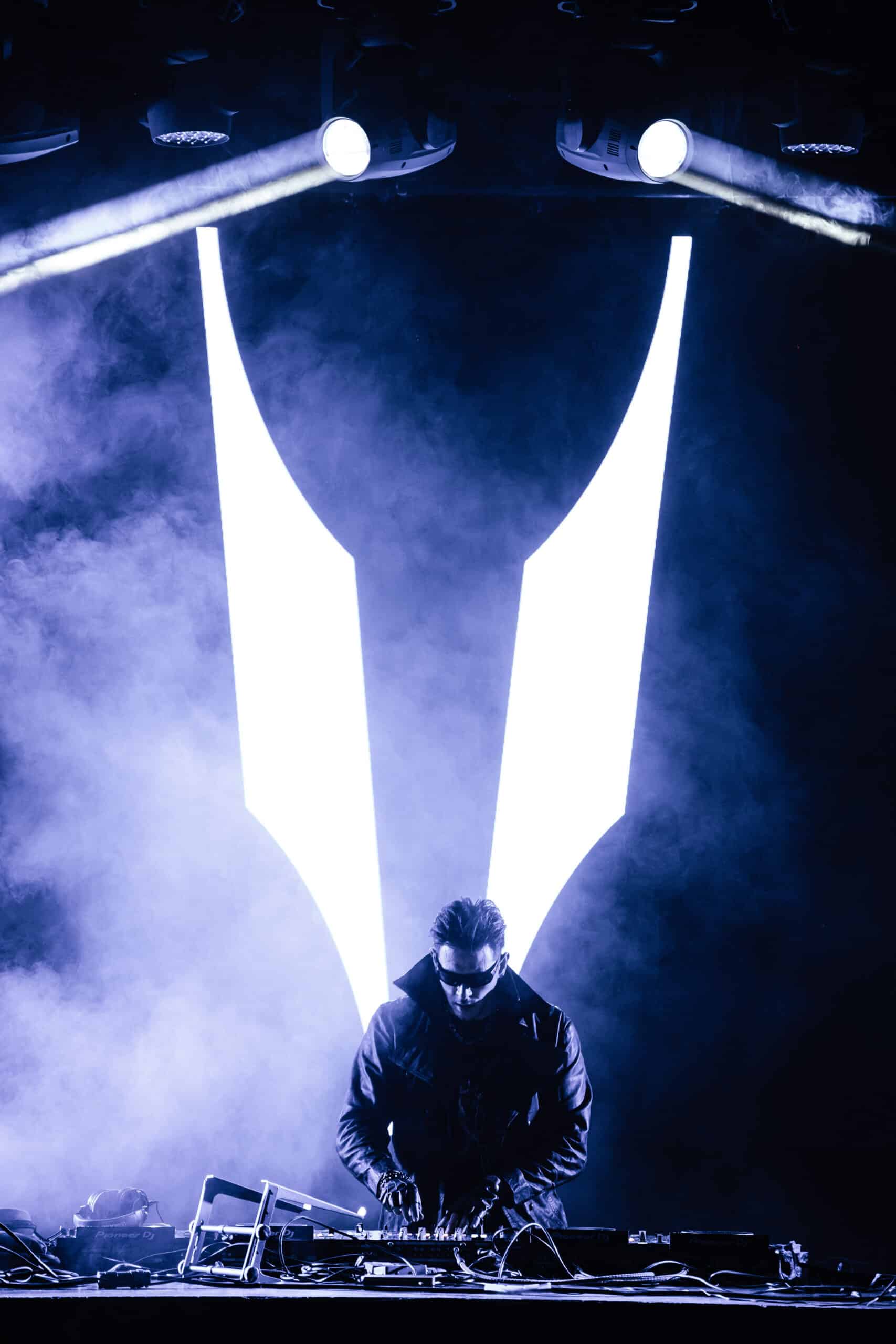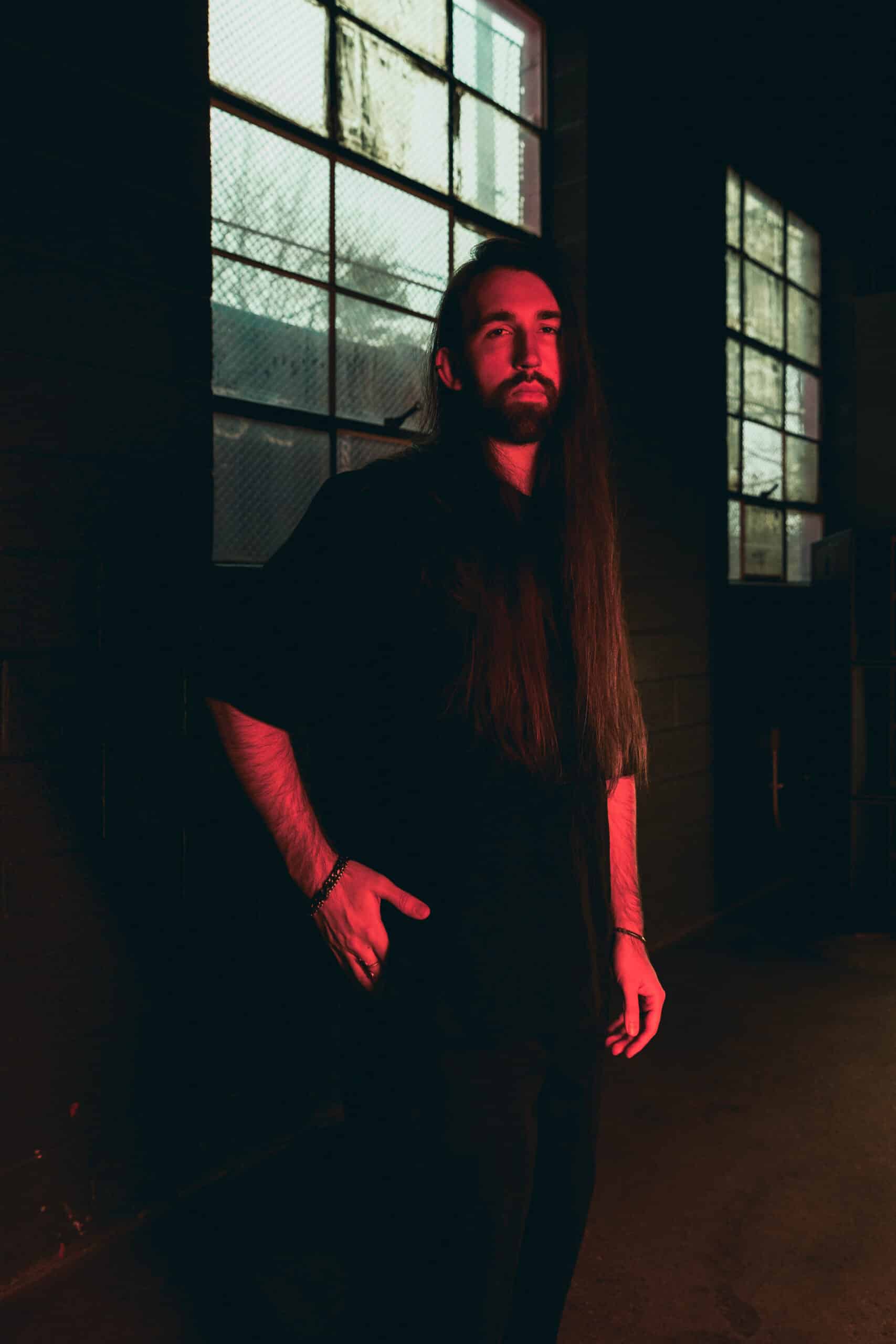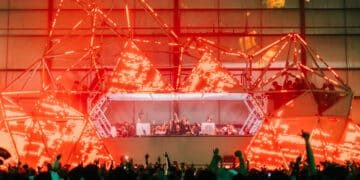DRAKK and FÜÜLROD stopped by to share insight into the story of KKULA and reflect on the techno scene.
A few weeks ago, DRAKK and FÜÜLROD joined forces to release the first compilation album, SYNDICATE VA 1, on their brand-new label, KKULA. The imprint is the result of their vision to place music, artists, and fans at the forefront of their endeavors. Aiming to set trends instead of follow them, KKULA prides itself on prioritizing quality over quantity in dark electronic music.
Both label bosses are deeply engrossed in the hard techno scene, making them ideal candidates for reshaping its landscape. DRAKK is currently one of the leading artists in the North American hard techno scene. He focuses on schranz, but he adds his own twist by injecting it with bigger energy, vocals, and buildups. FÜÜLROD is also a master of his craft as he’s found a signature style through his experience in the European techno scene while drawing elements from his early life as a drummer in Detroit.
SYNDICATE VA 1 was the perfect introduction to the world that DRAKK and FÜÜLROD are building. They emphasized that they are on a mission to highlight multiple perspectives of techno music while remaining true to their mission statement. Now that KKULA has been unveiled to fans worldwide, we sat down with DRAKK and FÜÜLROD to dive deeper into their plans for the label, their origins, the state of the techno scene, and so much more!
Be sure to stream SYNDICATE VA 1 on Spotify, and read on for our full conversation with DRAKK and FÜÜLROD!
Before we dive into KKULA, let’s briefly talk about you two. How did you two first get involved in the music industry, and what led you to pursue artist projects?
DRAKK: I decided to become a DJ after seeing Tiësto on his Elements of Life tour at the Bill Graham Civic Auditorium in San Francisco. Shortly after, I saved up money from working at a pizzeria to buy CDJ 400s. Within four to five months, I was already playing shows in San Francisco. For two years, I got booked two to three times every weekend.
I got tired of only opening, so I decided to level up by making my own productions. At the time, people who produced their own tracks got billed higher on lineups regardless of DJ and production skill. Around 2013-2014, I said, “Okay, it’s time to produce.” I even got a record on EDM.com called “Bounce, “which charted #1 for seven months. That was a big deal back then.
I was always a hardcore raver and downloaded music before it came out. I was huge into trance and happy hardcore growing up. I’ve produced house, progressive house, hardstyle, and every genre you can imagine. In 2016, there was a full-circle moment when Tiësto played one of my tracks, “Electroshock” with Junkie Kid as my old alias, Shelboy. That’s when I realized I could do this. The Shelboy thing never went anywhere, though, and it didn’t really have a brand.
I got into techno because I loved the fat kicks and wanted to return to the roots of electronic music. Early hardstyle from 2002-2007 even sounds like what people call “hard techno” now. For me, it was the golden era of hardstyle. I quit Shelboy in 2017 and started experimenting with other styles within electronic music like halftime, inspired by Noisia and their label, Division. I loved other artists, like Gestaffelstein, who inspired me a lot. The dark, slowed-down tempo sounded eerie and original. That is what eventually spawned DRAKK.
FÜÜLROD: Music has always been a part of my life. I grew up playing the drum set in different metal bands around southeast Michigan as a teenager. At one point, I had a band called DELOK, which featured Eric Vanlerberghe, who is now much better known as the vocalist for I Prevail. Back then, we were just rehearsing in my basement. I still collaborate with former DELOK members like Chris Vogler when I want to incorporate metal sounds in my songs.
I had always enjoyed electronic music, starting with deadmau5 as a teenager. When I moved to Germany later, I got into techno and drum and bass. Around Munich, besides random raves in forests or under bridges, I used to love going to clubs like Rote Sonne and Bahnwärter Thiel. I fell in love with electronic music and continually found ways to combine it with my music experience from my previous life as a drummer.
After being in academia my whole life and working in research, I eventually realized that even though I enjoyed it, I was completely missing out on interacting more with people and exploring my creative side to the fullest. At a certain point, it became impossible to ignore. I decided to change directions, but the transition process took years. Since then, I have enjoyed honing my craft and meeting other musicians. It’s been a journey stranger than fiction.

Both of you are deeply involved in the hard techno scene, but your projects still feel unique from each other. What defines DRAKK, and what defines FÜÜLROD?
D: The name DRAKK comes from living like a vampire — sleeping all day, being awake all night, having pale skin from never being in the sun, and purple eyes from staring at a computer screen for years. For me, it has always been about the groove, so I naturally gravitated towards schranz. Not only is it hard, but it still captures the core of techno. It’s repetitive, but in a good way. I wanted to take Schranz and inject it with bigger energy, vocals, and buildups while staying true to the essence of the sound.
F: I like to combine metal, sci-fi, and industrial sounds in my music while keeping a punk or underground ethos. I keep things a bit more rooted and upfront. My artist name started as a joke from when I studied nuclear engineering. A fuel rod is a tube containing the nuclear fuel inside a nuclear reactor. As things got more serious, it morphed into FÜÜLROD, which is its own thing now. It’s hilarious to hear people try to pronounce it, and I never correct them.
Even with differing styles, you two joined forces to create the KKULA label. What sequence of events led to its creation?
D: We released on the same VA compilation, and I reached out to Karl [FÜÜLROD] to tell him I liked his music. We kept in contact and ended up meeting backstage at an Alignment show during Amsterdam Dance Event in 2022. The next year, I had a few shows in Europe and stayed with him for a few weeks. I am super thankful for that. I rotted on the floor of Karl’s one-bedroom apartment on an air mattress.
F: Yeah, it was definitely a fun trip. We became good friends, made music together, and ended up making “FREAK,” which was later released on Luciid’s imprint, Agony. We found out we liked a ton of the same music and valued the same things in general.
What is the significance of the KKULA name to the story behind its inception?
D: DRAKK is spawned from the name “Dracula,” and the label is the second half of DRAKK with double K’s. I thought that sounded cool. KKULA is not just a label, though. It’s a community, clothing, and event brand. We want to uplift artists and not gatekeep or repress them. We want to support artists regardless of following, status, or anything else that doesn’t have to do with music. We are in a time where everything is reversed. Music is 20% while followers and status are the main factors in the scene. We want to fix that.
F: Our symbol is abstract. It’s not intended to represent anything besides the label itself, but it is also an easter egg for us. It could look like the bite from a vampire, or the umlauts above the Us in my logo. We both wanted to do things properly after getting fed up with stuff in the music industry around the same time, and the label started very naturally. We slowly brought in people to help as we took on more work.

You two have made it clear that KKULA will serve as a community space for creators and their followers. What sets KKULA apart from the rest of the scene, and how will you use this unique identity to evolve the hard techno scene and beyond?
D: If an artist plays four to five tracks of yours, I think it’s goofy to go and say, “Thanks for the support,” on social media. Are they truly supporting you? 90% of “DJs” never even credit the producer properly. It creates a hierarchy and environment of jealousy, which is the opposite of what techno should be.
Instead, it should be a community that uplifts and supports each other. That’s what the music is for. That is what we want to fix with KKULA. In our artist manifesto, one of the key things stated is, “Music first and fair treatment to artists.”
F: I’ll try to answer with a few examples without rambling on too much. First, we have the KKULA manifesto, which is a living document with guidelines for ourselves, our music, and our visual artists. The idea is that it is always evolving. We try to treat all our artists fairly and transparently, including visual artists we work with and other non-artist staff like legal (shout out Brian Drach) and management.
One way we try to support artists is simple. When we play big events and play other artists’ tracks out, we tag them on social media to credit the producer. This is done a lot in other genres besides hard techno. It’s the right thing to do, and it helps the entire community. This goes for everything. We even tag our video editor, Christina Coffee, in our social posts. We want to share our success with the people who deserve it —the ones who produced the art in the first place, and not just the last step in the process, which is the DJ playing the track.
With KKULA active in full force, what is the thought process behind scouting new artists and records that will be integral to the label?
D: Good and well-produced music regardless of sub-genre within techno. That’s pretty much it.
F: We try to release music from a mix of big artists and lesser-known artists, especially ones from underground communities in places where people might think, “Wait, there’s techno there?” So if someone is part of an underrepresented community or from a place where they have to fight to make a track or play a show, of course, we will consider that.
The first compilation album, SYNDICATE VA1 just released a few weeks ago, and it already has tons of support. All of the artists involved set a high bar, so what else can fans expect from the label for the rest of the year?
D: Two artist EPs and another VA, hopefully around October. We’re currently working on merch, which will hopefully come out around the same time as the VA. We are already working on showcases for KKULA in 2026. Expect nothing but high quality from KKULA.
F: We are both going to release music ourselves as well. I am also very excited about some of the artists we are already talking to for further releases.
Follow KKULA:
Follow DRAKK:
Instagram | SoundCloud | TikTok | Spotify
Follow FÜÜLROD:
Instagram | SoundCloud | TikTok | Spotify








